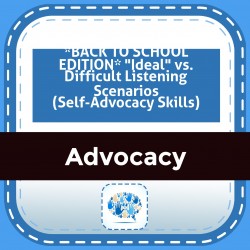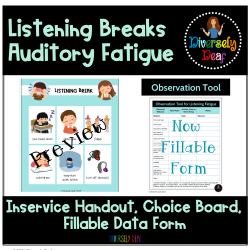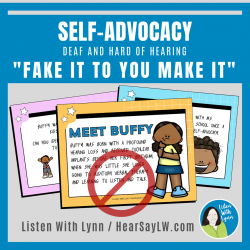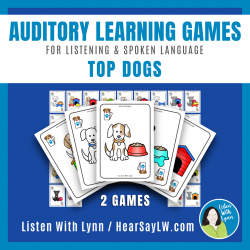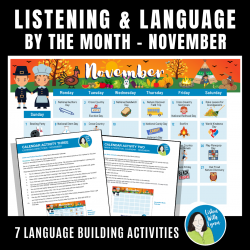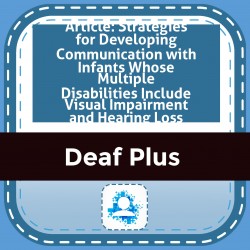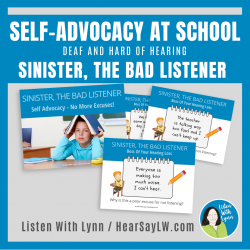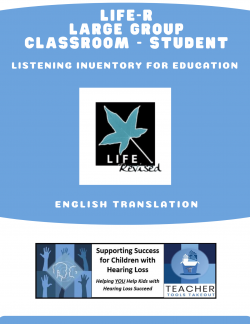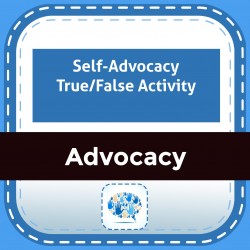Ability Levels
Categories
Resource Types
Age/Grade Range
CCSS
Anchor Standard
Speaking & Listening
Language
Reading
*BACK TO SCHOOL EDITION* "Ideal" vs. Difficult Listening Scenarios (Self-Advocacy Skills)
$ 375
This resource contains 15 possible listening situations for DHH learners. Read each scenario and have your student decide if this is an "ideal" listening situation or a "difficult" listening situation
...
Listening Breaks & Auditory Fatigue
$ 7
Ways this product can be usedInservice HandoutClassroom PosterStudent Choice BoardDiscussion starter with DHH kidsData collection tool Printable and FILLABLEThe visuals representing listener break cho
...
oices are useful for students with hearing differences who need a listening break but are not self-aware or unable to manage the fatigue before it impacts their education.The observation tool is used by staff to collect data and identify factors similar to the process of an FBA. Is there a pattern? Is it occasional, frequent, or chronic? What precedes the fatigue? Hungry? Good night sleep? If listener fatigue is a possibility discuss your findings with the Teacher of the deaf.
SELF-ADVOCACY Fake It To You Make It Communication Success Activity
$ 7
FAKE IT TO YOU MAKE IT is a fun and motivating no-prep grab & go SELF-ADVOCACY resource for elementary and middle school-aged kids who are deaf and hard of hearing. If you're looking for a new twist t
...
st to self-advocacy lessons you are at the right place.THIS RESOURCE HAS THREE PARTS:PART ONE:The part of the lesson and self-advocacy content is taught through a colorful nine-page story.Buffy the main character hears with cochlear implants and is relatable for kids that are deaf and hard of hearing. Kids love the comic-like story format!The story is great for auditory comprehension, story recall, and re-telling activities.PART TWO:Next, we meet eight of Buffy's friends who are also deaf and hard of hearing.There are eight situations - one for each friend.The goal is to identify different ways the kids try to bluff or fake it to get by.Each scenario is a common situation that kids with hearing loss face at school, at home, with peers, and in their community.Talking points with guided questions/discussion prompts for each scenario.Kids grapple with the challenging situations to foster self-advocacy learning.PART THREE:Buffy has learned a lot about self-advocacy and shares -Tips For Communication Success.Most importantly Buffy learned that bluffing doesn't work!INSTRUCTIONS1. The therapist, teacher, or parent reads the story about Bluffy and leads a discussion.2. The children listen to each of the eight scenarios. Each scenario can be taught as individual mini-lessons and introduced over time. One or more scenarios per lesson/session.3. The adult uses the questions and discussion prompts to foster self-advocacy learning.WHAT'S INCLUDED:✧ A PDF story that teaches the lesson content.✧ 8 situations or mini-lessons✧ Comic-like pictures illustrate the situations✧ Talking points with guided questions/discussion prompts✧ Advocacy StrategiesDIGITAL - NO PRINT The PDF can be opened and played with your iPad or tablet. When playing on a computer, open and use a PDF reader such as Adobe Acrobat Reader DC which is free. ➼ PRINT - This is an option but will use a great deal of ink due to the graphics.◈ ◈ ◈ ◈ ◈ ◈ ◈ ◈ ◈ ◈ ◈ ◈ ◈ ◈ ◈ ◈ ◈ ◈ ◈ ◈ ◈ ◈ ◈ ◈ ◈ ◈ ◈ ◈ ◈ ◈ CUSTOMER TIPS➼ Questions? EMAIL ME before purchasing this resource or anytime later♥ Sign-up HERE for the Listen With Lynn Emails♥ Let’s ConnectInstagramFacebookKeep up your good work. I am blessed to help along the way.Thanks so much!Lynn Wood
TOP DOGS Two Listening and Language Auditory Learning Games
$ 7
If you looking for TWO listening and language games to play all year long you’ve come to the right place! These fun dog-loving games are an easy, stress-free way to practice listening skills, and buil
...
s, and build spoken language, descriptive vocabulary, questioning skills, and auditory processing skills.YOU CAN TARGET: These games target and can build auditory memory, comprehension, processing, descriptive vocabulary, grammar, using clear speech, and social skills.TWO GAMES IN ONE RESOURCE: Game 1: TOP DOG* is a two-player game where players use differential yes or no questions to listen and isolate a specific dog based on critical elements. Game 2: GO FETCH* is a two or more-player game where players ask questions and listen to match pairs of dogs and their belongings cards. Kids love these cute and cuddly dogs and ask to play time and time again. I have used versions of both of these games SUCCESSFULLY for years while working with children who are deaf and hard of hearing, those with auditory processing needs, and students who need to develop listening skills.* These games are versions of the traditional Go Fish and Guess Who games that are played with rules to target listening and spoken language skills. Both games can easily be adapted to meet a child’s ability level. The cards can be sorted into sets of fewer cards which would be an easier listening set. Use all 36 different card designs for a more complex game.INCLUDES:✧ A complete guide with detailed instructions ✧ 36 enticing colorful game cards used for both TOP DOG and GO FETCH!✧ A digital gameboard for Top Dog✧ Listening and Spoken Language TipsFACE TO FACE - TELETHERAPY - HOME✢ PRINT - One-time easy prep. ✢ DIGITAL - The Top Dog digital gameboard can be opened and played with your favorite PDF reader app on a tablet or iPad. Tokens can be placed directly on the screen.on a computer. Open the PDF game board with the 36 spring egg images and use a PDF reader such as Adobe Acrobat Reader DC which is free. The listener used the annotation tools to mark the cards like Lotto.YOU ASKED. I LISTENED. I created a second dog-themed resource based on many of your requests and the rave reviews that kids are so motivated by my LOST DOG and MY PET CAT animal activities. You will want all three resources in your Listening and Language Toolbox.PLEASE NOTE: This activity and the LOST DOG resource contain many of the same images that are bright, enticing, and vocabulary rich. However, these two resources target completely different auditory and language-based goals.◈ ◈ ◈ ◈ ◈ ◈ ◈ ◈ ◈ ◈ ◈ ◈ ◈ ◈ ◈ ◈ ◈ ◈ ◈ ◈ ◈ ◈ ◈ ◈ ◈ ◈ ◈ ◈ ◈ ◈ CUSTOMER TIPS:➼ Questions? Email me before purchasing this resource or anytime later.➼ Sign-up HERE for the Listen With Lynn Emails♥ Let’s Connect:InstagramFacebookKeep up your good work. I am blessed to help along the way.Thanks so much!Lynn Wood
NOVEMBER LISTENING VOCABULARY COMPREHENSION
$ 5
The NOVEMBER Listening and Language By The Month resource includes seven activities that can be used ALL MONTH for auditory memory and comprehension, seasonal vocabulary, developing grammar, and build
...
Article: Strategies for Developing Communication with Infants Whose Multiple Disabilities Include Visual Impairment and Hearing Loss
$ 2
Article from California Deaf-Blind Services on specific strategies for developing communication in infants with hearing loss.
Self-Advocacy Sinister, The Bad Listener
$ 5
This resource is a hilarious self-advocacy activity. Your students will say it is their favorite activity and, you will know they are learning to become the boss of their hearing loss. It was created
...
to encourage self-advocacy skills in children who are deaf and hard of hearing but is effective when targeting listening skills in all kids.The Premise: Sinister has two ears, wears great hearing devices, and has been in listening and language therapy since he was a toddler. But, it doesn’t matter. Sinister is a BAD listener! He doesn’t try and makes up excuses for not listening. Sinister gets in a whole lot of trouble because he doesn’t listen.The adult leads a discussion using Sinister’s poor excuses for not listening. Kids love imagining the trouble Sinister gets himself into because he doesn’t listen. This activity is an easy, no-prep way to encourage the child to be Boss of Your Hearing Loss. Parents can use it at home, teachers and therapists both face-to-face and during tele-practice. While not age-specific it has been successfully used with kids in 1st grade and up through middle school. This resource can be easily leveled up or down to meet various children's goals and needs.Sinister The Bad Listener requires no prep or planning because everything is in this resource. It can be easily used by parents at home, teachers, and therapists both face-to-face and on tele-platforms. This Digital - No Print resource can be opened and played with your favorite PDF reader app on a tablet. When playing on a computer, open and use a PDF reader such as the free Adobe Acrobat Reader DC. Boom LearningSinister the Bad Listener is also available as a Boom Deck in the Listen With Lynn Boom Learning store. Please note: Sinister The Bad Listener is a serve-and-return conversational game between the adult and the listener. There is no audio component or sound bytes included.◈ ◈ ◈ ◈ ◈ ◈ ◈ ◈ ◈ ◈ ◈ ◈ ◈ ◈ ◈ ◈ ◈ ◈ ◈ ◈ ◈ ◈ ◈ ◈ ◈ ◈ ◈ ◈ ◈ ◈ ◈ ◈You'll love all these resources for kids with hearing loss and self-advocacy activities!❤ ❤ Check out the Bundle of 8 Self-Advocacy $$ saving bundle! SELF-ADVOCACY Tips For Communication Success (Free)SELF-ADVOCACY The 5 L's For Listening (Free)SELF-ADVOCACY This or That?SELF-ADVOCACY Bluffing Never Have I Ever ActivitySELF-ADVOCACY Role Play Real-Life ConnectionsSELF-ADVOCACY Scenarios At Group Gatherings & CelebrationsSELF-ADVOCACY Sinister The Bad ListenerSELF-ADVOCACY Scenarios - Turning Lemons Into LemonadeSELF-ADVOCACY Perk Up Your Ears (Ear-related sayings and idioms)SELF-ADVOCACY Listen & Draw Directions◈ ◈ ◈ ◈ ◈ ◈ ◈ ◈ ◈ ◈ ◈ ◈ ◈ ◈ ◈ ◈ ◈ ◈ ◈ ◈ ◈ ◈ ◈ ◈ CUSTOMER TIPS:➼ Click here to stay updated!➼ Be the first to know about freebies, sales, and product launches.➼ New products are 50% off the first 24 hours
STAY CONNECTED:✧ Sign-up here for the Listen With Lynn Email✧ Follow on Facebook
✧ Follow on Instagram
✧ Feel free to email me with questions, before purchasing this resource or anytime later.
❤ Keep up your excellent work. I am blessed to help along the way. Thanks so much! Lynn
Large Group Student LIFE
$ 4
This checklist is designed to be a pretest/post-test when a Classroom Amplification Distribution System (CADS or soundfield amplification) is used in a classroom in which large group instruction is pr
...
esented. It can be used with a selected subgroup of students, or all students can be asked to complete the checklist. Each student rates his/her general responsiveness during instruction on a 1-5 rating scale. Includes room for minimal comments. Results will be most valid for students in grade 4 or ages 9-10 and above.
Self-Advocacy True/False Activity
$ 350
This product contained 20 statements in flashcard form focusing on self-advocacy skills. You can use this as a fun end of the year activity or even as an assessment to gauge your student's understand
...
ding of self-advocacy skills. This would also be an excellent way to reinforce/support the difficult concept of "true or false" with your students.Read each statement to the student. Ask them to decide if the statement is "true" or "false."
 Your browser is out of date. For best experience switch to latest updated Browser.
Your browser is out of date. For best experience switch to latest updated Browser.
 Get Chrome
Get Chrome Get Edge
Get Edge Get Firefox
Get Firefox
